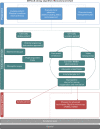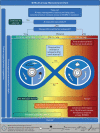Airway management in neonates and infants: European Society of Anaesthesiology and Intensive Care and British Journal of Anaesthesia joint guidelines
- PMID: 38018248
- PMCID: PMC10720842
- DOI: 10.1097/EJA.0000000000001928
Airway management in neonates and infants: European Society of Anaesthesiology and Intensive Care and British Journal of Anaesthesia joint guidelines
Abstract
Airway management is required during general anaesthesia and is essential for life-threatening conditions such as cardiopulmonary resuscitation. Evidence from recent trials indicates a high incidence of critical events during airway management, especially in neonates or infants. It is important to define the optimal techniques and strategies for airway management in these groups. In this joint European Society of Anaesthesiology and Intensive Care (ESAIC) and British Journal of Anaesthesia (BJA) guideline on airway management in neonates and infants, we present aggregated and evidence-based recommendations to assist clinicians in providing safe and effective medical care. We identified seven main areas of interest for airway management: i) preoperative assessment and preparation; ii) medications; iii) techniques and algorithms; iv) identification and treatment of difficult airways; v) confirmation of tracheal intubation; vi) tracheal extubation, and vii) human factors. Based on these areas, Population, Intervention, Comparison, Outcomes (PICO) questions were derived that guided a structured literature search. GRADE (Grading of Recommendations, Assessment, Development and Evaluation) methodology was used to formulate the recommendations based on those studies included with consideration of their methodological quality (strong '1' or weak '2' recommendation with high 'A', medium 'B' or low 'C' quality of evidence). In summary, we recommend: 1. Use medical history and physical examination to predict difficult airway management (1С). 2. Ensure adequate level of sedation or general anaesthesia during airway management (1B). 3. Administer neuromuscular blocker before tracheal intubation when spontaneous breathing is not necessary (1С). 4. Use a videolaryngoscope with an age-adapted standard blade as first choice for tracheal intubation (1B). 5. Apply apnoeic oxygenation during tracheal intubation in neonates (1B). 6. Consider a supraglottic airway for rescue oxygenation and ventilation when tracheal intubation fails (1B). 7. Limit the number of tracheal intubation attempts (1C). 8. Use a stylet to reinforce and preshape tracheal tubes when hyperangulated videolaryngoscope blades are used and when the larynx is anatomically anterior (1C). 9. Verify intubation is successful with clinical assessment and end-tidal CO 2 waveform (1C). 10. Apply high-flow nasal oxygenation, continuous positive airway pressure or nasal intermittent positive pressure ventilation for postextubation respiratory support, when appropriate (1B).
Copyright © 2023 The Author(s). Published by Wolters Kluwer Health, Inc. on behalf of the European Society of Anaesthesiology and Intensive Care.
Figures
References
-
- Apfelbaum JL, Hagberg CA, Connis RT, et al. 2022 American society of anesthesiologists practice guidelines for management of the difficult airway. Anesthesiology 2022; 136:31–81. - PubMed
-
- Disma N, Virag K, Riva T, et al. Difficult tracheal intubation in neonates and infants. NEonate and Children audiT of Anaesthesia pRactice IN Europe (NECTARINE): a prospective European multicentre observational study. Br J Anaesth 2021; 126:1173–1181. - PubMed
-
- Fiadjoe JE, Nishisaki A, Jagannathan N, et al. Airway management complications in children with difficult tracheal intubation from the Pediatric Difficult Intubation (PeDI) registry: a prospective cohort analysis. Lancet Respir Med 2016; 4:37–48. - PubMed
-
- Jagannathan N, Asai T. Difficult airway management: children are different from adults, and neonates are different from children. Br J Anaesth 2021; 126:1086–1088. - PubMed



